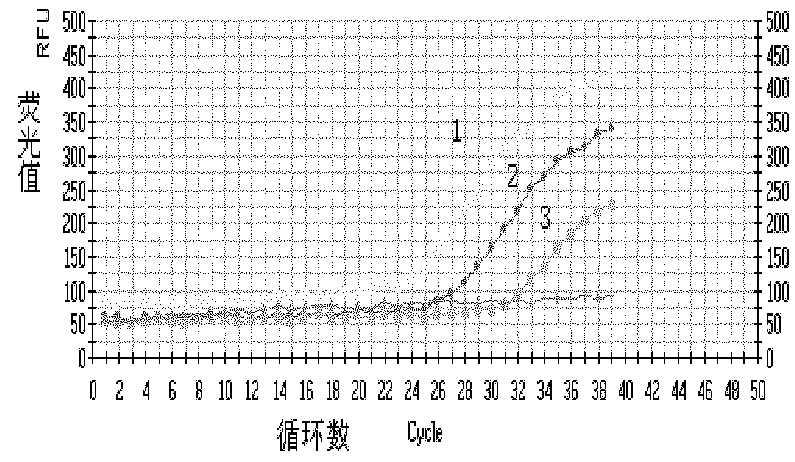Reagent for detecting Yersinia pestis and method for carrying out fluorescence quantitative PCR (Polymerase Chain Reaction) detection on Yersinia pestis
A Yersinia, fluorescent quantitative technology, applied in the direction of fluorescence/phosphorescence, biochemical equipment and methods, microbial measurement/inspection, etc., can solve the problems of easy cross-contamination, poor sensitivity of the method, and incapable of quantitative analysis, etc., to achieve Guaranteed specificity and easy operation
- Summary
- Abstract
- Description
- Claims
- Application Information
AI Technical Summary
Problems solved by technology
Method used
Image
Examples
Embodiment 1
[0023] The preparation of embodiment 1 primer and probe
[0024] 1. Target gene selection
[0025] The Yersinia pestis 6MD plasmid has the pst gene that produces Yersinia pestis and the gene of plasma coagulase and plasminogen activator pla, which is considered to be related to human pathogenicity and can be used as the gene of Yersinia pestis Diagnostic sign. The pla gene sequence was obtained by searching the genbank database.
[0026] 2. Design and screening of fluorescent probes, quencher probes and PCR primers
[0027] According to the principle of compound probe design, two sets of primers and probes were designed according to the sequence of pla gene. The 5' end of the fluorescent probe is labeled with fluorescent molecule FAM as a reporter group, and the 3' end is labeled with phosphate to block its extension. A quenching group Dabcyl is connected to the 3' end of the quenching probe.
[0028] In order to screen out a combination with high amplification efficiency...
Embodiment 2
[0055] Embodiment 2, the detection of Yersinia pestis
[0056] In order to investigate the actual application ability of the detection of the present invention, simulated samples such as blood, water samples, soil, and surface stains contaminated by Yersinia pestis were specially prepared, and pure bacteria were set as positive controls, and non-plague pathogenic bacteria were used as negative controls. .
[0057] 1. Sample Preparation
[0058] (1).Preparation and processing of contaminated blood: fixed-value Yersinia pestis was serially diluted with anticoagulant blood to make a concentration of 1×10 6 CFU / ml-1×10 1 CFU / ml of contaminated blood samples. Take 1ml of blood containing different concentrations of bacteria, centrifuge at 12000rpm for 10 minutes, discard the supernatant, add 1ml of red blood cell lysate (50mmol / LTrisHCL, 25mmol / L KCl, 5mmol / LMgCl 2 , pH7.5, TKM solution), vigorously shake and mix for 2 minutes, centrifuge at 12000rpm for 10 minutes, discard the...
PUM
 Login to View More
Login to View More Abstract
Description
Claims
Application Information
 Login to View More
Login to View More - R&D
- Intellectual Property
- Life Sciences
- Materials
- Tech Scout
- Unparalleled Data Quality
- Higher Quality Content
- 60% Fewer Hallucinations
Browse by: Latest US Patents, China's latest patents, Technical Efficacy Thesaurus, Application Domain, Technology Topic, Popular Technical Reports.
© 2025 PatSnap. All rights reserved.Legal|Privacy policy|Modern Slavery Act Transparency Statement|Sitemap|About US| Contact US: help@patsnap.com



